London Blue Topaz Clarity
Those of us who, like so many consumers these days, have fallen in love with the color of London Blue Topaz naturally want to ensure they know what they're buying. While color is the hallmark of this gemstone, ensuring the London Blue designation falls within a narrow band, clarity can vary quite a bit more. To help you make an informed decision when making a London Blue Topaz jewelry purchase, we've assembled this guide to the most important aspect of its value: clarity.
TABLE OF CONTENTS
What is London Blue Topaz?
By definition, London Blue Topaz is topaz stone that has a specific medium blue color. It's darker than aquamarine or Swiss Blue Topaz, but lighter than what we normally look for in a blue sapphire. Topaz itself is a fluorinated aluminum silicate, and has a Mohs hardness of 8. This makes it harder than quartz, but not as hard as corundum (e.g. sapphire or ruby) or diamonds. It often occurs with quartz crystals.
London Blue Color & Treatment
Although there is some blue topaz in nature, it is rare. When naturally blue topaz occurs, it is light in color. London Blue Topaz is generally brown or colorless material that's been irradiated and then heat treated to obtain the dark blue, which does not occur in nature. Fortunately, this is a permanent color change, so you don't have to worry about the color fading over time. While irradiation is less common, most colored gemstones sold today are heat treated. In addition to helping produce the blue color, heating improves the clarity of the stone. While synthetic London Blue Topaz is available, at With Clarity we only sell mined topaz that is treated.
Gemstone Clarity
After cutting, a finished gemstone is assigned a clarity grade before being set into London Blue Topaz jewelry. This means that topaz which is heat treated and/or irradiated often scores higher on the London Blue Topaz clarity scale, increasing its value. However, as a rule, most topaz is already eye clean, making it what the GIA calls a “type 1” gemstone.
There are basically four quality grades of natural topaz: AAAA, AAA, AA, B. According to the most commonly used scale, AAAA grade topaz has a vibrant natural color and so clear of inclusions that it's hard to see them under magnification if they're there at all.
However, London Blue Topaz is not a natural color, but enhanced. The highest grade of London blue topaz is AAA, which denotes either enhanced color or that the hue is less intense than AAAA. Inclusions might be easier to see under magnification, as well. AA or even B is the lowest quality used by independent jewelers, and this material tends to have muted colors and inclusions that are clearly visible under magnification. At With Clarity, we set our London Blue Topaz engagement rings with AAA-grade stones.
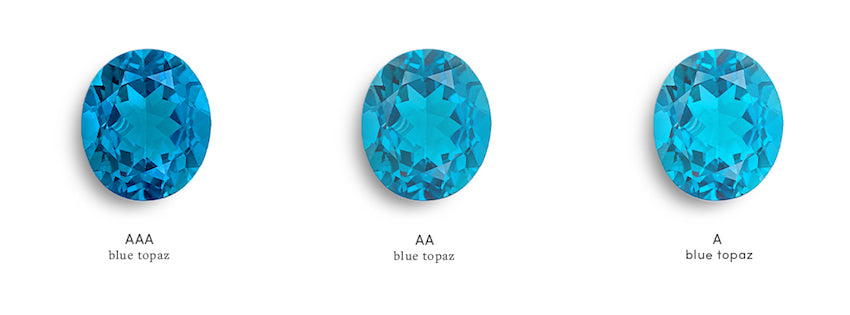
How Cut Influences Clarity
Before any gemstone is set into jewelry, it is cut and polished. While the size of a gemstone is important to its selling price, for most gemstones clarity is very important. To maximize its place on the London Blue Topaz clarity scale, rough topaz is cut in such a way that most of the inclusions are removed from the finished product.
If a gem cutter is skilled, this can be done effectively without wasting too much of the rough stone. Remember, the topaz clarity review is performed on the finished product, not the rough version of the gem. Besides the removal of inclusions, gem cutters aim for a specific shape or style of cut when fashioning a gem from the rough. Here are the types of cuts frequently seen in London Blue Topaz:
Step Cuts:
These are the type of cut where rectangular and square facets predominate. The facets are lined up parallel to each other, allowing a "hall of mirrors" effect. With step cuts, there isn't much sparkle, and inclusions are much harder to hide. However, the gorgeous color of London Blue Topaz is heightened by the facets. Most popular among the step cuts is the emerald cut. This rectangular-shaped stone is shown off beautifully as a London Blue Topaz rose gold ring Other examples include the asscher cut (square) and baguette (thin rectangle).
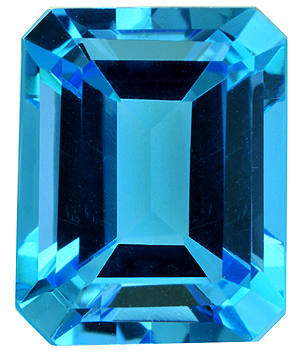
Brilliant Cuts:
These are so named because they have many facets intended to give more brilliance to a gem. These facets allow light to reflect back at the person viewing the stone, and they can be placed in such a way that the stone is curved. Most of the facets are kites or triangles. By far the most popular brilliant cut is the round cut. If that’s your taste, consider a round London Blue Topaz engagement ring. Other brilliants include oval, marquise (pointed oval), pear, princess (square), and heart.
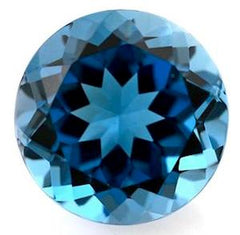
Cabochons:
Usually chosen for London Blue Topaz that has inclusions but a deep blue color. This is the oldest type of gem cutting, and cabochons are usually round or oval stones with a smooth, polished top. This often creates a beautiful gem, because the deep blue color hides many of the inclusions.
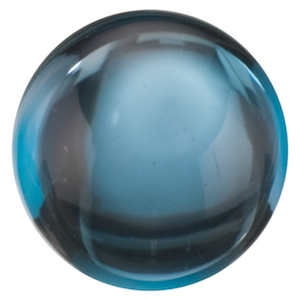
Types of Inclusions
While London Blue Topaz doesn't usually have inclusions in faceted stones, they still can in their rough forms. Here are the more common types of topaz inclusions.
Crystals:
Sometimes a topaz crystal will run into a tiny crystal of another mineral type during formation. These usually look like small specks, though they could be larger.

Needles:
These are tiny, fiber-like inclusions that look like needles. Technically they are also crystal inclusions, but look different from the ones above.
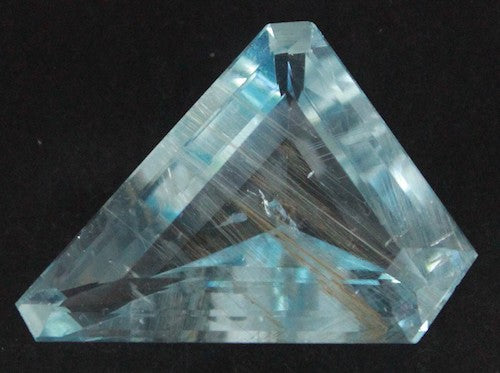
Twinning:
What happens when two large topaz crystals grow together. It looks like parallel cracks where the edges of the two crystals run together.
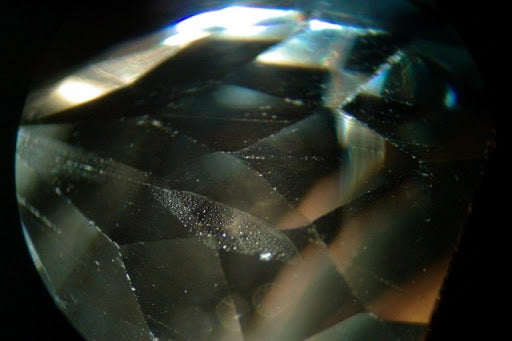
Cleavage Fault:
Really a crack in the stone, not a foreign object. Because they're brittle, this is also common in topaz.
London Blue Topaz at With Clarity
Do you want a London Blue Topaz ring in white gold? We have a wide variety of them available in our store, with prices ranging between $400 and $2,000. They can all be set in yellow, rose, or white gold. We can also make a custom creation if you don't find the perfect ring for your taste. Give us a call if you have any questions. Contact us by phone at 1(844)-234-6463 or email at service@withclarity.com. Our Live Chat is available during business hours Monday - Friday 10AM - 6PM ET.
FAQs
Is all London Blue Topaz heat treated?
How is London Blue Topaz graded?
What kind of inclusions does Topaz have?
Topaz can have a variety of inclusions, which are internal characteristics or impurities that are present within the gemstone. These inclusions can affect the gemstone's appearance, durability, and value. Some common types of inclusions found in topaz are as follows:
- Crystal inclusions: Small crystals of other minerals that are visible within the topaz.
- Needles: Long, thin inclusions that resemble needles.
- Bubbles: Small, round inclusions that resemble bubbles.
- Veils: Wispy and thin inclusions that can resemble a veil or cloud.
- Feathers: Inclusions that resemble feathers and can cause a hazy or cloudy appearance in the gemstone.









